5 Best Bulgarian Split Squat Variations (with Pictures!)
The Bulgarian split squat is a classic lower body exercise made popular by its challenging unilateral stance.
To the surprise of many, the Bulgarian split squat is not actually the end-all of its kind. There exist quite a number of variation exercises that further build upon its numerous benefits - allowing lifters with specific needs to better meet their goals.
While the conventional Bulgarian split squat is the most widely-applicable variation, lifters who have trouble balancing during the exercise can perform the assisted Bulgarian split squat instead.
Likewise, those that wish to further maximize quadriceps recruitment can try the deficit or heel-elevated variants.
What is a Bulgarian Split Squat?
Bulgarian split squats are a unilateral closed chain compound movement where one leg is elevated behind the body and the other is bent forwards.
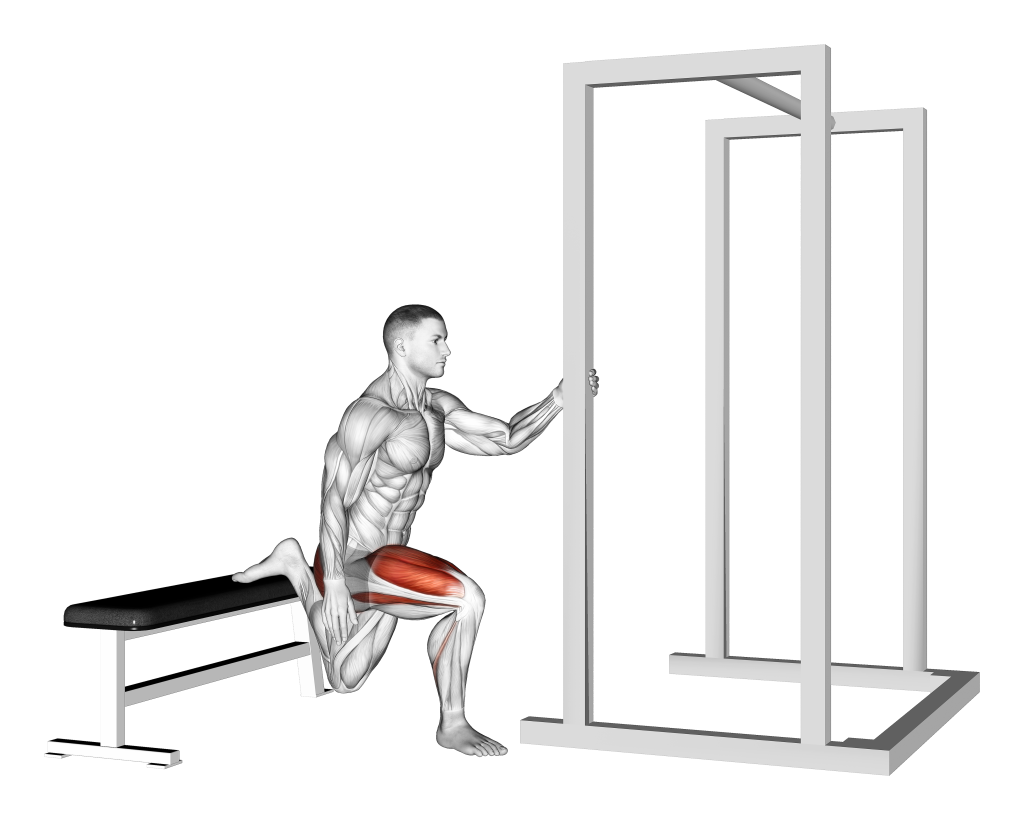
Nearly all Bulgarian split squat variations will prioritize the quadriceps femoris, but also target the glutes and hamstrings on one side of the body.
Bulgarian split squats are most often performed as a method of building strength, mass and athletic ability in the lower body. Depending on the skill and experience of the lifter, they can be done entirely unweighted or with a number of different types of training equipment.
The majority of Bulgarian split squat variations feature small changes in the elevation of the feet, or otherwise different methods of placing resistance around the body.
Both alterations change which muscles are emphasized and can create a more intense exercise as a whole.
A Note on Equipment and Bulgarian Split Squat Variations
Occasionally, Bulgarian split squats performed with different types of equipment (i.e. barbells or kettlebells) are considered to also be variations of the same exercise.
For the sake of brevity, we have instead chosen to list only the fundamental changes in movement pattern that make a variation. Unless otherwise specified, this means that any exercises listed below can be performed with your choice of equipment - or none at all, for that matter.
Bulgarian Split Squat Variations
1. The Conventional Bulgarian Split Squat
Also simply referred to as just “Bulgarian split squats”, the conventional variation is the baseline form of Bulgarian split squat that most other variants are based off of.
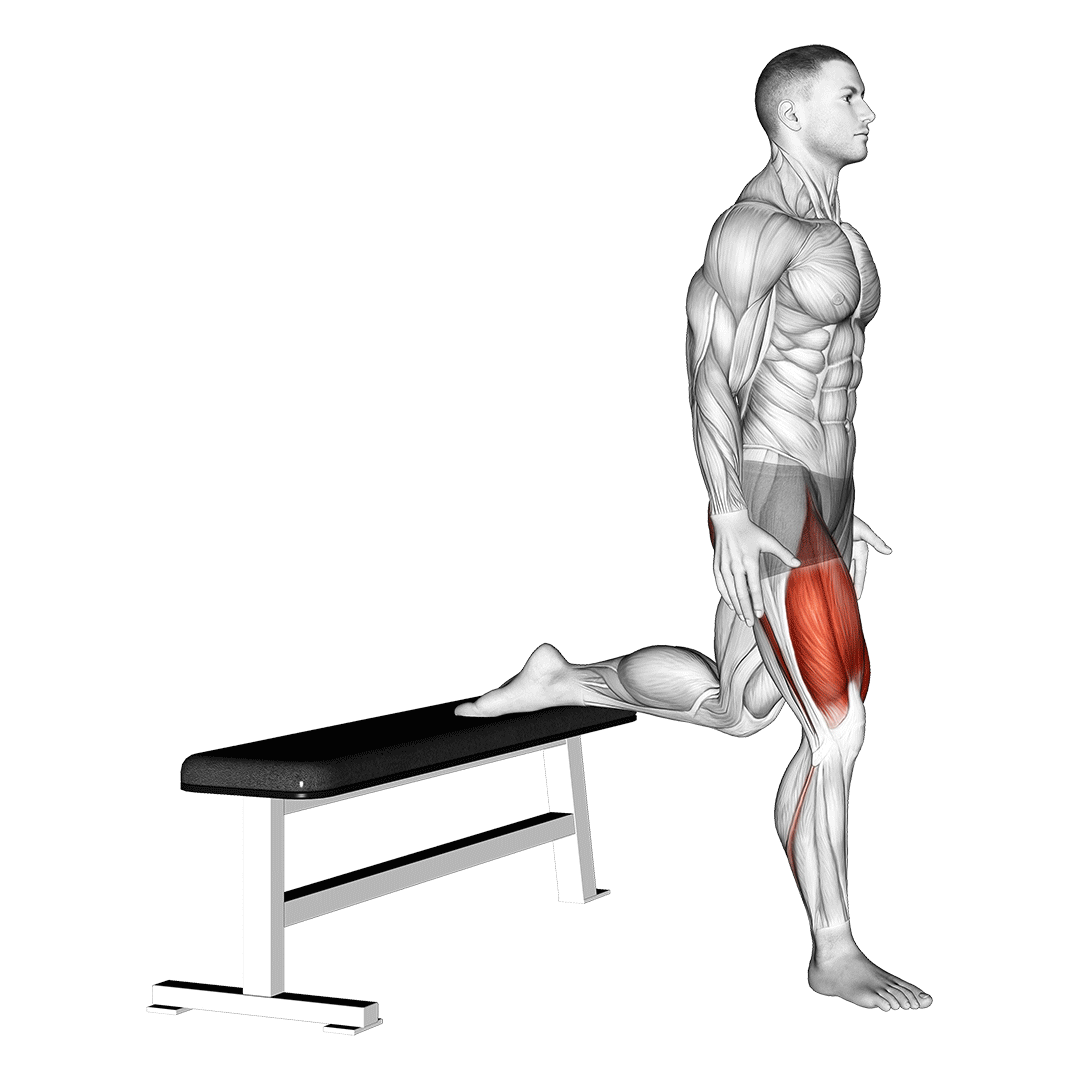
It features a standard one-leg elevation and with the remaining foot flat along the ground. If performing the exercise with weight, they are generally held in both hands or atop the back.
Like most other Bulgarian split squat variations, the conventional kind is considered to be an intermediate level unilateral compound movement performed so as to train the lower body in some way.
Depending on programming, this can be general quadriceps hypertrophy, improved strength in a staggered stance or even carryover to non-gym physical activities.
Muscles Worked
The conventional Bulgarian split squat prioritizes the quadriceps femoris, but will also work the muscles of the hamstrings and glutes to a lesser extent.
In addition, depending on stance width and whether performing the movement weighted or not, the core, erector spinae, hip flexors and calves may also be used.
Benefits as a Bulgarian Split Squat Variation
The main benefit of conventional Bulgarian split squats is its capacity to act as a general training tool of the lower body.
For greater hypertrophy, less weight and more volume can be selected. For strength and power development, the opposite.
Bulgarian split squats are even known to improve agility, balance and coordination in athletic training tools due to their unique stance and challenging movement pattern.
How-to:
To perform a repetition of the conventional Bulgarian split squat, the lifter will stand facing several feet away from an exercise bench, feet set slightly wider than hip-width apart and toes pointing forwards.
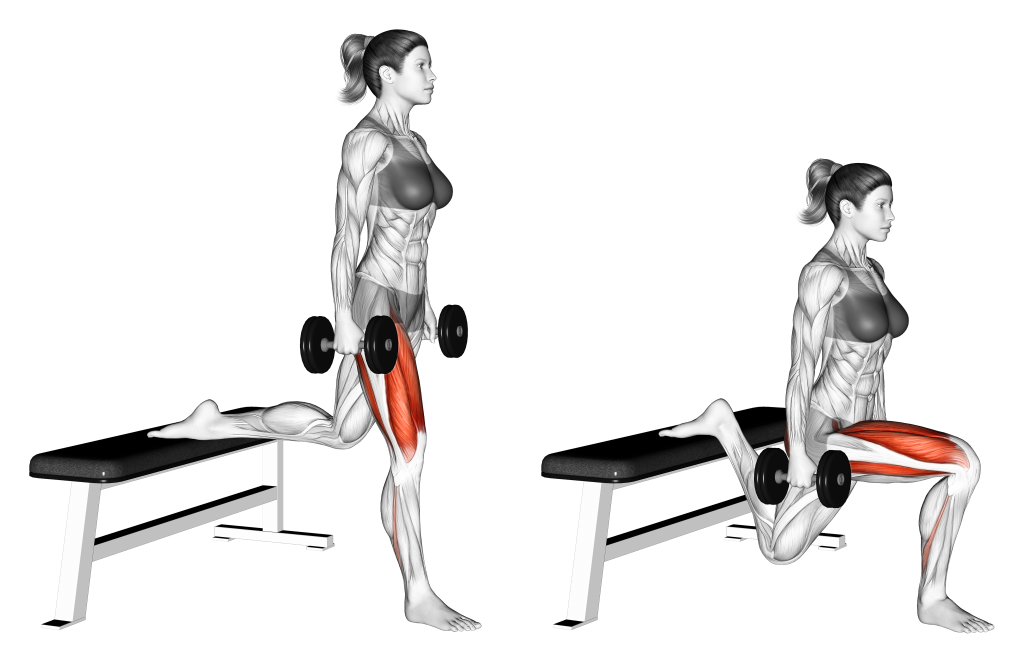
Taking one leg and placing it soles-up atop the bench behind them, the lifter then shifts their weight towards the still-standing foot, bending it slightly at the knees, bracing their core and keeping the spine neutral.
From this stance, the lifter then bends both knees simultaneously, keeping the torso upright as they do so.
This should lower them to a point where both knees are at a 90 degree angle of flexion, with which the lifter will drive through their foot and rise back upwards. At this point, the repetition is considered to be complete.
2. The Assisted Bulgarian Split Squat
For lifters with trouble maintaining balance with conventional Bulgarian split squats, performing the exercise assisted by holding on to an object with one arm is perfectly fine.
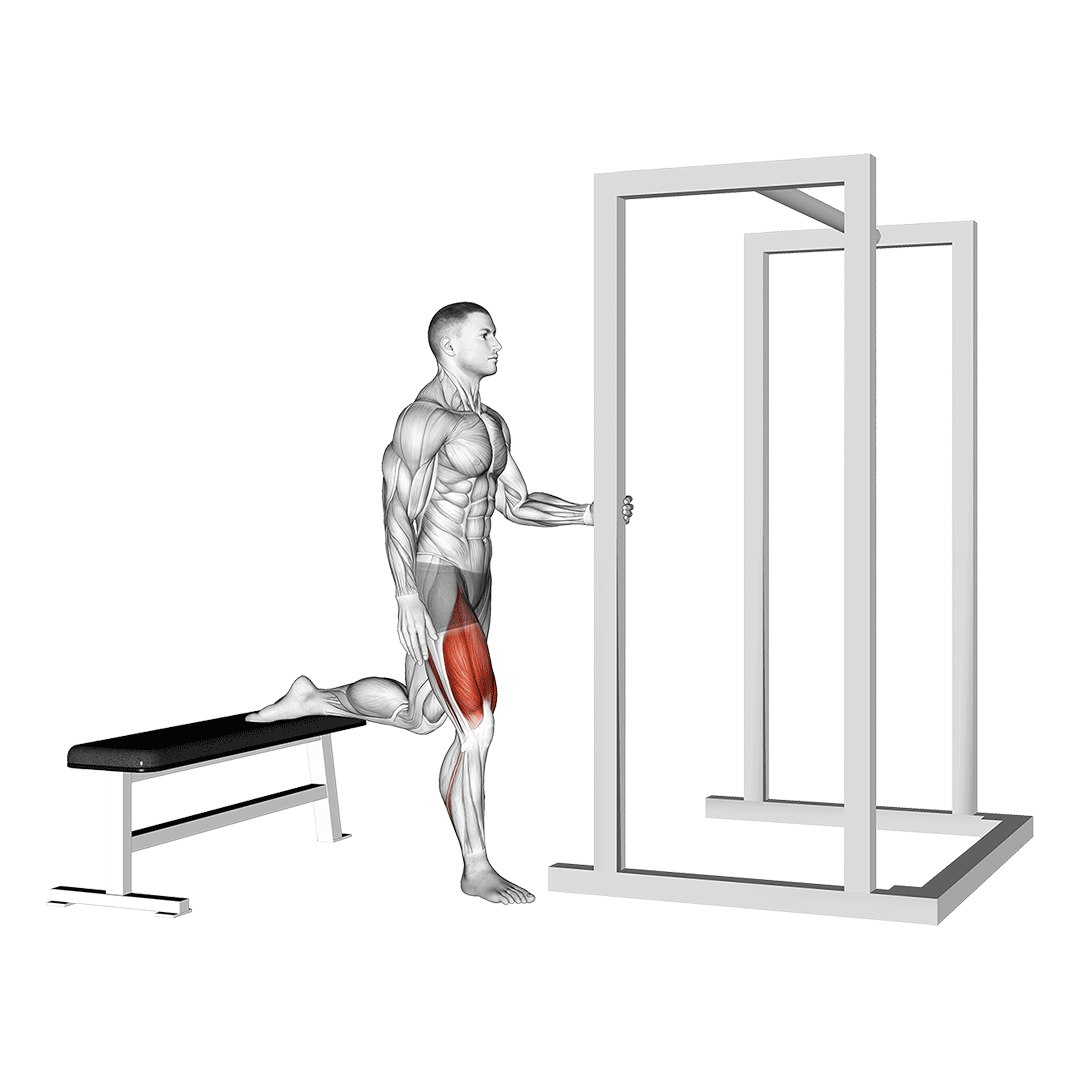
While otherwise identical in all other aspects, the assisted Bulgarian split squat can allow lifters with poor balance to perform the exercise with less demand for stability and a minor decrease in how much weight is placed on one leg.
Assisted Bulgarian split squats are primarily done by novices or individuals just returning to training after an injury. In certain cases, they are also used as a supplementary movement alongside heavier movements like the back squat, lunges or even conventional Bulgarian split squats themselves.
Muscles Worked
The assisted Bulgarian split squat works the same muscles as its conventional counterpart; the quadriceps, glutes and hamstrings.
Markedly less isometric contraction of muscle groups like the calves, erector spinae and core will be seen, however.
Benefits as a Bulgarian Split Squat Variation
Apart from being more accessible than its conventional cousin, the assisted Bulgarian split squat also features a markedly lower risk of injury as less of the body’s weight is placed on a single knee joint at once.
Lifters without the space of equipment to perform wall-assisted Bulgarian split squats can instead make use of a pole or pipe in their hand - pressing the bottom end into the floor so as to assist them during the set.
How-to:
Performing the assisted form of Bulgarian split squat is much the same as performing the conventional variant. This means one foot soles-up atop a bench behind the body, the other bearing most of the body’s weight.
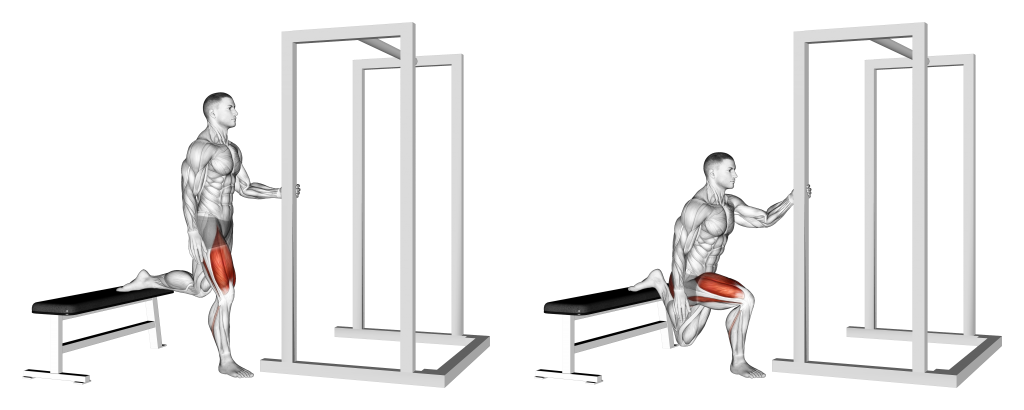
Unlike other variations however, the assisted kind has the lifter stretch out one arm and grip a nearby stable object for support. If not present, a pole may be gripped in this arm with the bottom pressed against the floor, as if using a walking stick.
It is up to the lifter to decide how much weight they distribute into the supporting object. So long as the pelvis remains only slightly tilted forwards and the torso upright, leaning on the object for support is perfectly fine.
With the body now supported, the lifter will proceed to perform the exercise by bending both knees into a 90 degree angle.
From this point, the repetition may be completed by the lifter driving into their still-standing foot and rising back into an upright position.
3. The Deficit Bulgarian Split Squat
Deficit Bulgarian split squats are a variation performed with the standing leg elevated off the ground, increasing the exercise’s range of motion and leading to greater development of the lower body.
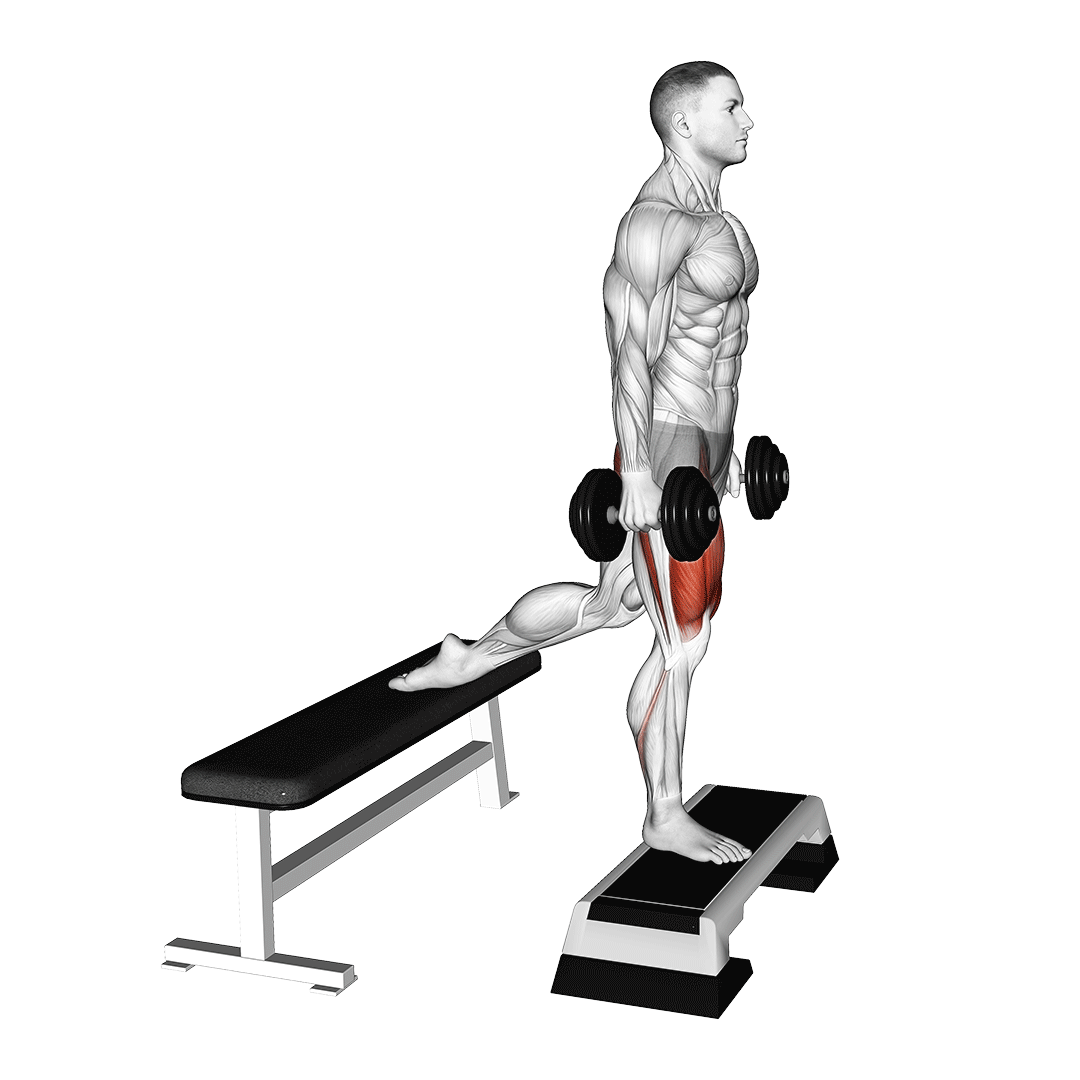
The deficit Bulgarian split squat will generally elevate the lifter’s foot higher off the ground the greater their mobility is, often making use of weight plates, plyo boxes or other stable objects to do so.
Deficit Bulgarian split squats are considerably more advanced and difficult than other exercises on this list, and should only be performed once conventional Bulgarian split squats have already been mastered.
Muscles Worked
Deficit Bulgarian split squats will emphasize the quadriceps and glutes the most, but also feature significant recruitment of the hamstrings as well.
In addition, because of a greater squatting depth, the hip flexors are worked to a comparatively greater degree than with other variations.
Benefits as a Bulgarian Split Squat Variation
Deficit Bulgarian split squats are seen as a more intense and challenging variation than conventional Bulgarian split squats. Because of the greater time under tension caused by a larger range, the deficit variant is considerably effective for maximizing hypertrophy and stability in the quadriceps femoris.
Furthermore, performing Bulgarian split squats in a deficit can act as an accessible form of progression for individuals who do not have access to weights or wish to avoid using them.
How-to:
To perform a deficit Bulgarian split squat, the lifter will assume the standard Bulgarian split squat stance with one foot elevated behind them and the body’s weight shifted to the remaining foot.
Where the two differ, however, is that the forward-facing leg is planted atop a platform, raising it off the floor.
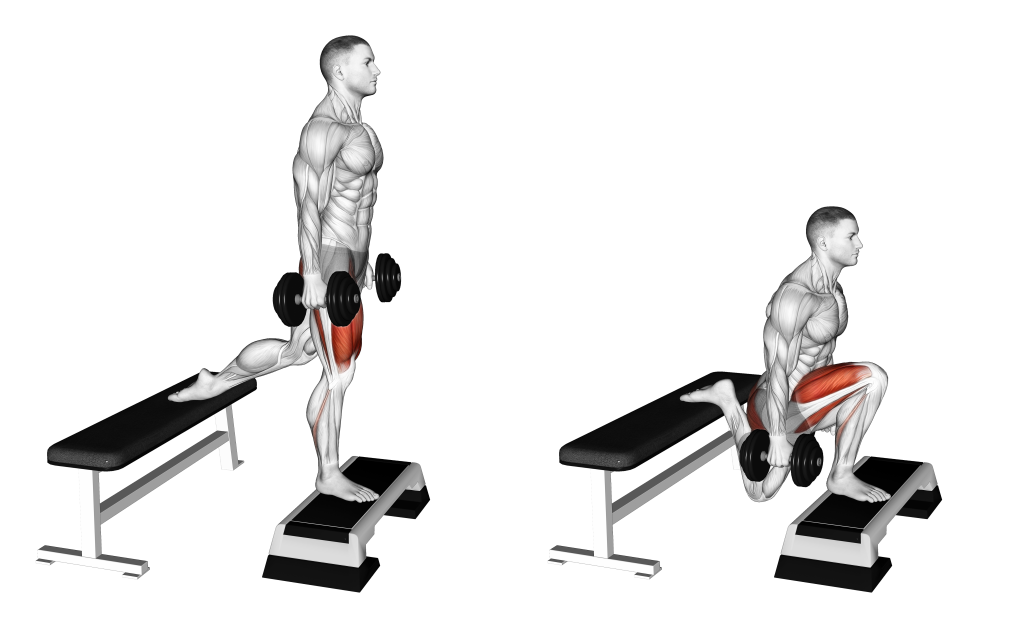
With both feet elevated off the ground, the lifter then performs the exercise as normal by bending both knees simultaneously and lowering their hips downwards.
Rather than stopping once the knees are both at a 90 degree angle, the lifter will continue to lower themselves until reaching the limit of their mobility. Care should be taken to keep the forward-facing knee tracking in the same angle as the toes.
From this depth, they then drive through their heel and rise back to an upright position so as to complete the repetition.
4. The Heel-Elevated Bulgarian Split Squat
Exactly as it sounds, the heel-elevated Bulgarian split squat is a conventional Bulgarian split squat performed with the front-facing heel raised, often with the use of a wedge or weight plate.
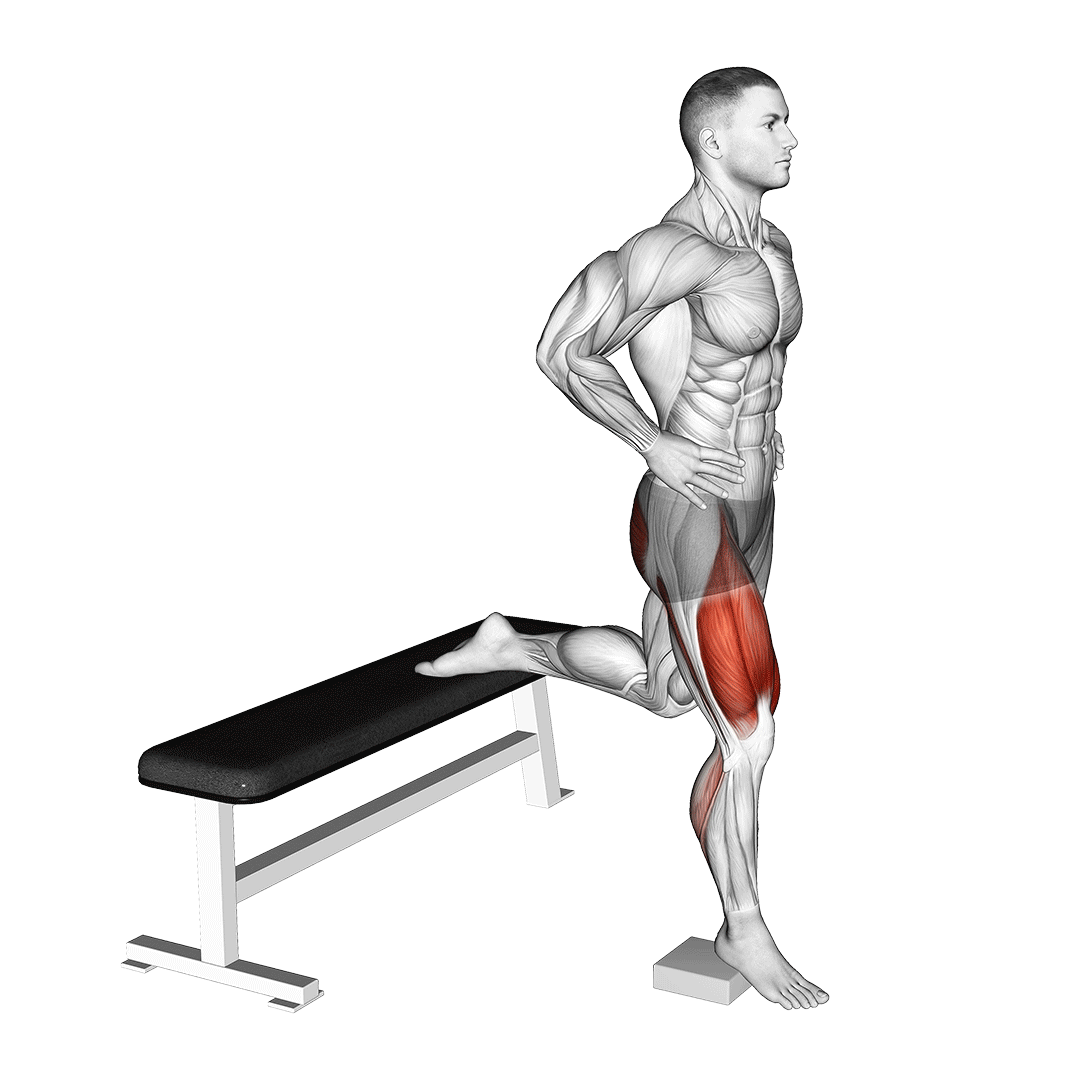
This elevation of the heels is done in order to increase how much of the upper body’s weight is shifted to the working leg, as well as aiding individuals with poor ankle mobility.
Otherwise, the heel-elevated Bulgarian split squat is mechanically the same as most other variants, and may be treated as such.
Muscles Worked
This particular variation of Bulgarian split squat targets the quadriceps to an even greater degree while still working the muscles of the posterior chain in the same capacity.
Benefits as a Bulgarian Split Squat Variation
Elevating the heel during Bulgarian split squats forces the knee to angle further forwards over the foot, shifting more of the body’s weight onto the same leg and altering the tracking of the knee by a small measure.
In addition, with less distance between the heel and the back of the shin, less mobility of the connective tissue therein will be needed as the tendons will not need to stretch as far to maintain a flat heel.
How-to:
To perform a heel-elevated Bulgarian split squat, the lifter will simply wedge a weight plate or similar object beneath their heel as they assume the standard stance. This means elevating one foot behind the body with the other bearing most of the body’s weight.
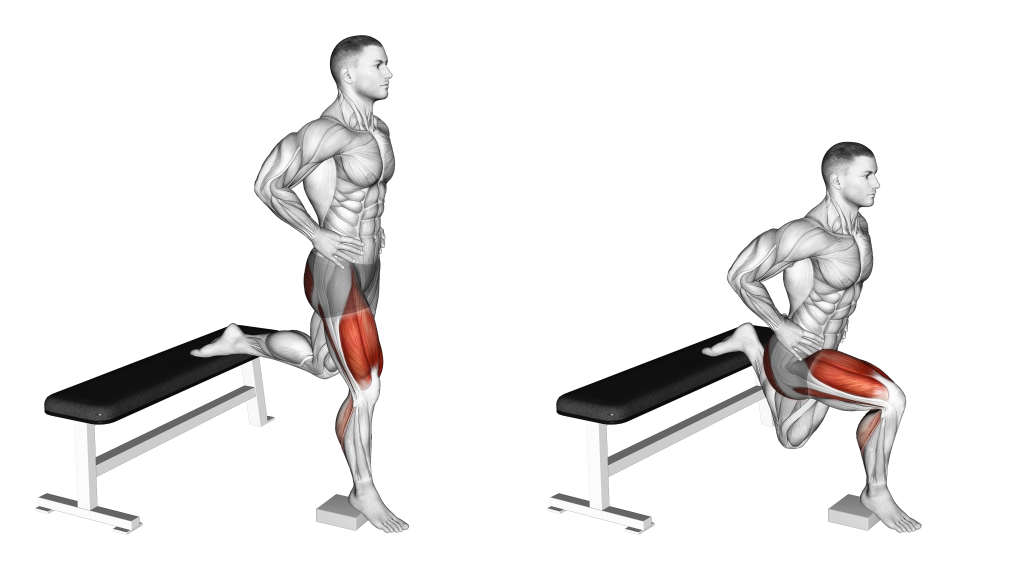
Ensuring the knee is tracking in the same direction as the toes beneath it, the lifter then bends both knees simultaneously - lowering themselves until both knees are at a 90 degree angle.
Depending on the angle at which the heel is elevated, the lifter may find their upper torso leaning forwards to compensate for balance.
This is a mistake, and can lead to excess pressure being placed on the knees and ankles. Instead, the lifter should allow their pelvis to tilt forwards, pushing the glutes back so as to help with balance.
From this point, the lifter drives into the wedge beneath their heel and rocks the torso back slightly, returning to an upright position so as to complete the repetition.
5. The Zercher Bulgarian Split Squat
Zercher Bulgarian split squats are a unique form of barbell Bulgarian split squat where the barbell is held in the crook of the elbows at the front of the torso.
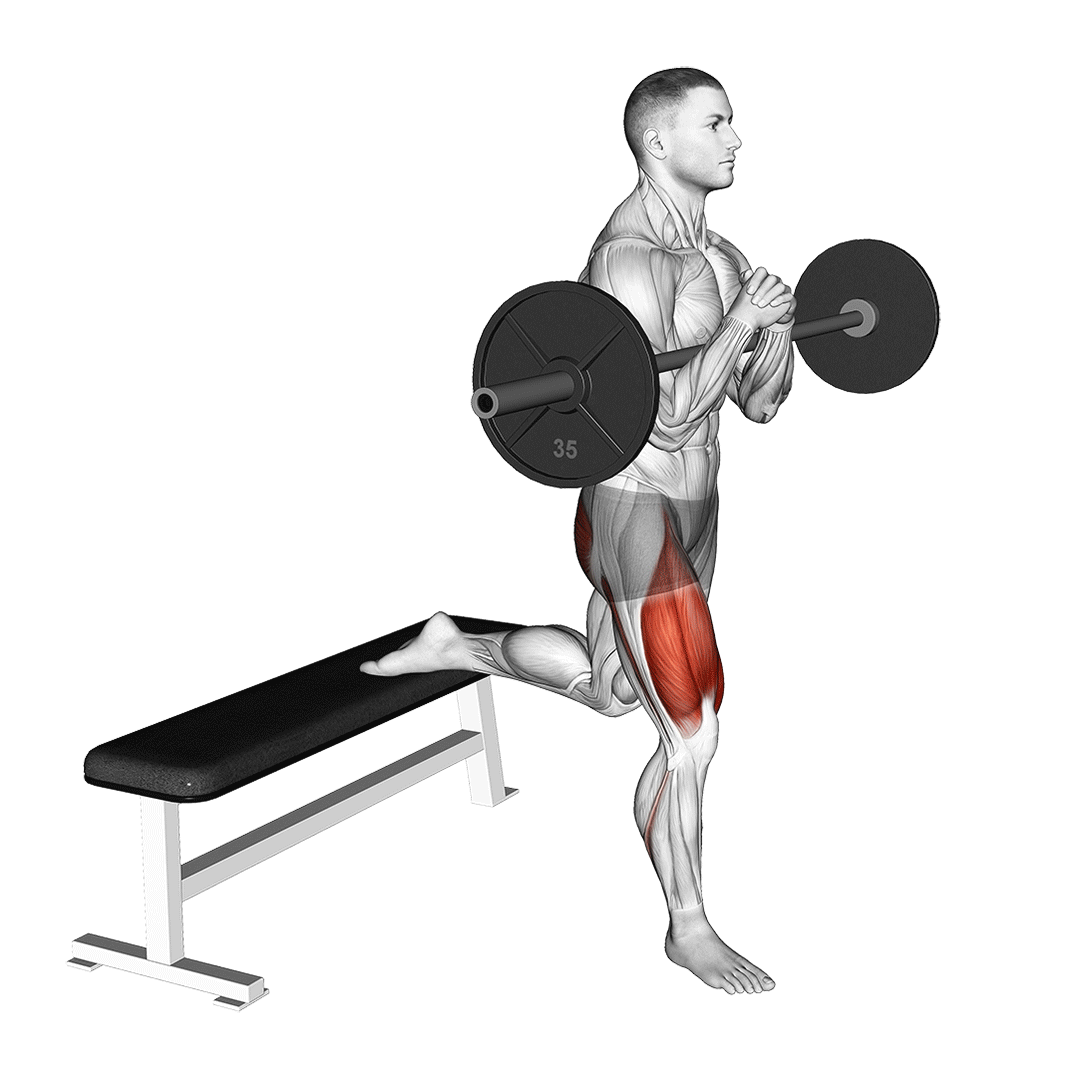
Like Zercher back squats, this barbell placement changes the orientation of the torso and reduces strain on the lower back and spine.
Apart from being used by individuals with backs sensitive to load, the Zercher Bulgarian split squat is also occasionally employed by athletes as a specialized exercise for carrying objects at chest height while in a staggered stance. This can be seen in strongman competitors, Olympic weightlifters or individuals with highly physical vocations.
Muscles Worked
Zercher Bulgarian split squats target the same lower body muscles as conventional Bulgarian split squats, only with a somewhat greater emphasis on the quadriceps femoris due to the anterior loading present.
However, in terms of stabilizer muscles, Zercher Bulgarian split squats greatly differ from all other variations. This is because the biceps, deltoids and chest all act to stabilize the barbell alongside the usual erector spinae and core muscles.
Benefits as a Bulgarian Split Squat Variation
As mentioned, the Zercher variation is quite useful for individuals that wish to avoid loading the spine and back in a vertical angle. Such an advantage can be useful for individuals with a history of spinal compression, poor upper back stability and a host of other back-related issues.
Of course, ensure you’re medically cleared for exercise prior to attempting the Zercher Bulgarian split squat.
How-to:
To perform a Zercher Bulgarian split squat, the lifter will begin by hoisting a barbell up to sternum-height in the crook of their elbows, paying extra attention to the curvature of their upper back and shoulders.
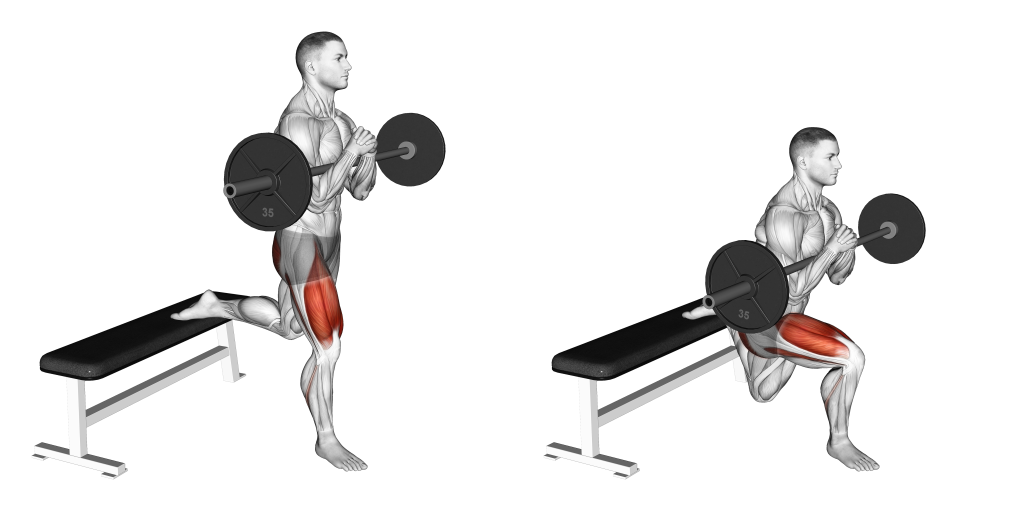
Once the barbell is stable within their arms, the lifter will then carefully set one foot behind them atop a bench, keeping the other flat on the ground. This should recreate the standard Bulgarian split squat stance with a slightly more upright angle to the torso.
Now in the correct stance, the lifter will simply bend at the knees and lower themselves until the rear knee is at a 90 degree angle of flexion.
Now at optimal depth, the lifter drives through their heel and rises back up - still being mindful of their torso’s angle. When upright once more, the rep is complete.
Which Bulgarian Split Squat Variation is the Best?
In truth, the majority of Bulgarian split squat variations are only small changes in what is an otherwise effective exercise. There is no “best” variation, as they are all quite similar.
If you are unsure of which to pick, we suggest sticking with the conventional variant until the need arises for any of its variations, such as the need for greater quadriceps emphasis or a deeper range of motion.
Although we’ve listed the five most effective Bulgarian split squat variations here, keep in mind that there are alternatives to the Bulgarian split squat itself.
If you find these variations uncomfortable or if they don’t meet your needs - try out alternative exercises like lunges, squat variations or step-ups.
References
1. Campbell, Adam., Women's Health Maga, Editors of. The Women's Health Big Book of Exercises: Four Weeks to a Leaner, Sexier, Healthier You!. United States: Harmony/Rodale, 2016. ISBN: 9781623368432, 162336843X
2. Konrardy, Craig, "Comparison of forward lean during Bulgarian split squat at high and low box heights" (2017). Dissertations and Theses @ UNI. 460. https://scholarworks.uni.edu/etd/460
